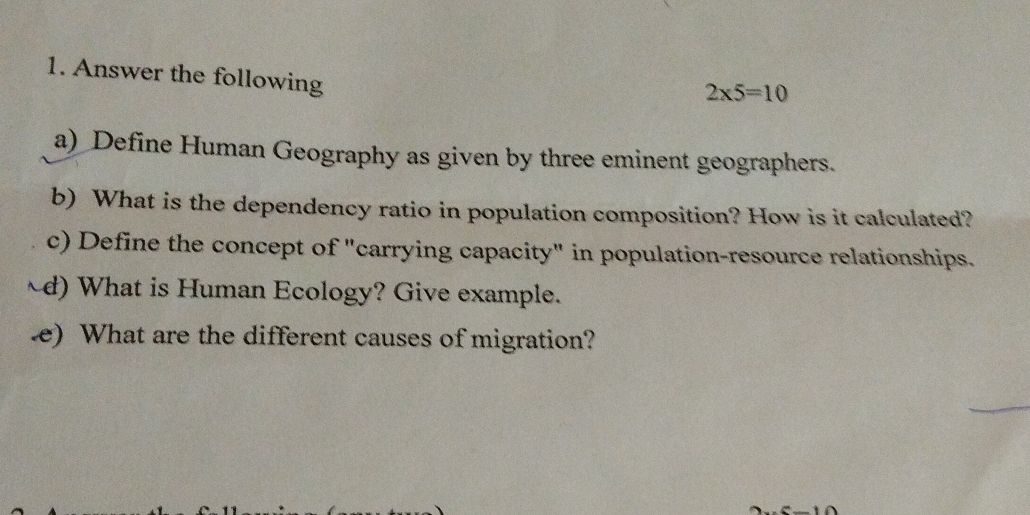Define Human Geography as given by three eminent geographers. What is the dependency ratio in population composition? How is it calculated? Define the concept of 'carrying capacity... Define Human Geography as given by three eminent geographers. What is the dependency ratio in population composition? How is it calculated? Define the concept of 'carrying capacity' in population-resource relationships. What is Human Ecology? Give an example. What are the different causes of migration?

Understand the Problem
The question is asking for definitions and explanations related to human geography, population composition, carrying capacity, human ecology, and migration causes. It seeks a detailed understanding of various concepts in human geography and ecology.
Answer
Definitions and explanations provided for human geography, dependency ratio, carrying capacity, human ecology, and migration causes.
a) Human Geography focuses on the relationship between humans and their environments, interpreted by geographers like Vidal de la Blache, Carl Sauer, and Paul Vidal.
b) The dependency ratio reflects the number of dependents (aged 0-14 and 65+) to the working-age population (15-64). It's calculated by dividing the number of dependents by the working population and multiplying by 100.
c) Carrying capacity refers to the maximum population size that an environment can sustain given its resources like food and water.
d) Human Ecology examines the interactions between humans and their environments, such as urban planning affecting resource allocation.
e) Causes of migration include economic factors, political instability, environmental changes, and social reasons like family reunification.
Answer for screen readers
a) Human Geography focuses on the relationship between humans and their environments, interpreted by geographers like Vidal de la Blache, Carl Sauer, and Paul Vidal.
b) The dependency ratio reflects the number of dependents (aged 0-14 and 65+) to the working-age population (15-64). It's calculated by dividing the number of dependents by the working population and multiplying by 100.
c) Carrying capacity refers to the maximum population size that an environment can sustain given its resources like food and water.
d) Human Ecology examines the interactions between humans and their environments, such as urban planning affecting resource allocation.
e) Causes of migration include economic factors, political instability, environmental changes, and social reasons like family reunification.
More Information
Dependency ratio is crucial in understanding economic pressure on the productive population. Carrying capacity often determines sustainable development practices.
Tips
A common mistake is confusing the dependency ratio with birth or mortality rates when analyzing population data.
Sources
- Population Composition - AP Human Geography - Fiveable - library.fiveable.me
- AP Human Geography: Vocabulary Lists - chino.k12.ca.us
AI-generated content may contain errors. Please verify critical information